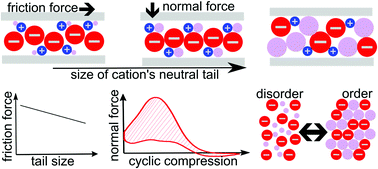Molecular dynamics investigation of the influence of the shape of the cation on the structure and lubrication properties of ionic liquids†
Abstract
We present a theoretical study of the influence of the molecular geometry of the cation on the response of ionic liquids (ILs) to confinement and mechanical strain. The so-called tailed model includes a large spherical anion and asymmetric cation consisting of a charged head and a neutral tail. Despite its simplicity, this model recovers a wide range of structures seen in ILs: a simple cubic lattice for small tails, a liquid-like state for symmetric cation–tail dimers, and a molecular layer structure for dimers with large tails. A common feature of all investigated model ILs is the formation of a fixed (stable) layer of cations along solid plates. We observe a single anionic layer for small gap widths, a double anionic layer for intermediate ones, and tail-to-tail layer formation for wide gaps. The normal force evolution with gap size can be related to the layer formed inside the gap. The low hysteretic losses during the linear cyclic motion suggest the presence of strong slip inside the gap. In our model the specific friction is low and the friction force decreases with tail size.



 Please wait while we load your content...
Please wait while we load your content...